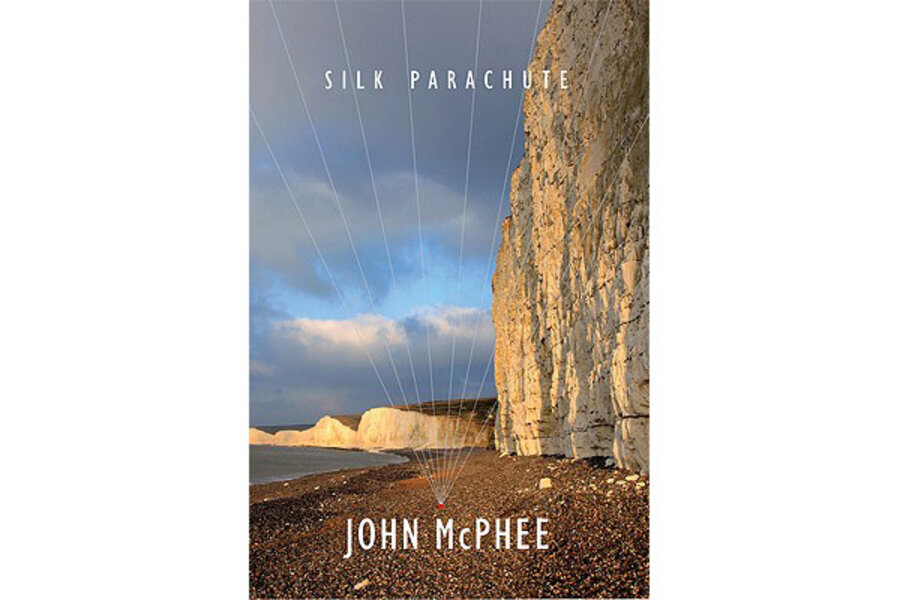Silk Parachute
Loading...
In dedicating Silk Parachute, his latest collection of essays, to his grandchildren, John McPhee perhaps inadvertently reminds readers of his longevity in American letters and his stature as a standard-bearer of a particular kind of literary journalism.
As a staff writer at The New Yorker since 1965, McPhee has come to define a New Yorker staple, what he calls in “Silk Parachute” the “long fact piece.” It’s typically an exhaustively researched, meticulously reported, and unapologetically lengthy article that lavishes fact upon fact, as a painter might build texture with successive layers of brush strokes, in an attempt to make an object of curiosity shimmer with fresh revelation.
McPhee’s chosen subjects often seem almost aggressively prosaic. He once wrote an entire book about oranges, and another one of his books is about shad fish. McPhee is also a longtime enthusiast of geology, a subject that doesn’t promise automatic commercial appeal.
Not everyone is a fan of McPhee’s work. Many years ago, fellow essayist Philip Lopate described it as a “scrupulously fair, sporting, impersonal fact-gathering style ... which reminds me of nothing so much as a colony of industrious termites capable of patiently reducing any subject matter to a sawdust of detail.”
What Lopate appeared to want in McPhee’s work was a more overtly personal point of view, and this is exactly what readers get in “Silk Parachute,” McPhee’s most personal book to date.
The book divides itself just about evenly between the longish reportage for which McPhee is most famous and smaller vignettes in which the first-person voice takes a starring role. The title essay is a small piece of memoir in which McPhee fondly remembers growing up with his mother. We have McPhee’s mother to thank for encouraging his love of observation, indulging his childhood wish to stand at La Guardia Field in freezing weather and watch the planes. “At LaGuardia,” McPhee recalls, “she accompanied me to the observation deck and stood there in the icy wind for at least an hour, maybe two, while I, spellbound, watched the DC-3’s coming in on final, their wings flapping in the gusts.”
During that excursion, McPhee’s mother bought him a toy parachute stuffed within a small, hinged ball. “Folded just so, the parachute never failed,” McPhee tells readers. “Always, it floated back to you – silkily, beautifully – to start over and float back again.”
The ideals evoked by that memory – beauty, balance, buoyancy – rest at the heart of McPhee’s writerly sensibility. They are well on display in “My Life List,” another deeply personal and wryly funny piece in which McPhee recounts some of the odd things he’s eaten on the road. The complete list cannot be duplicated here, but suffice it to say that bee spit, lion, porpoise, and puffin are included.
“My Life List” also offers an occasion for tongue-in-cheek portraits of McPhee’s fellow New Yorker writer Ian Frazier and the magazine’s legendary late editor William Shawn. Inspired by his long relationship with The New Yorker, “Silk Parachutes” features a good bit of shop talk, most notably in “Checkpoints,” in which McPhee chronicles the exacting and often hilarious lengths to which New Yorker fact-checkers will go to verify the accuracy of reporting. One such exercise involved phoning someone in London and dispatching him to Fitzroy Road to double-check that a blue ceramic plaque honoring William Butler Yeats was, in fact, blue and ceramic.
Another essay, “Season on the Chalk,” records a characteristic McPhee outing, using travelogue to explore the peculiar chalk geology “below the English Channel, under much of northern France, under bits of Germany and Scandinavia, under the Limburg Province of the Netherlands, and – from Erith Reach to Gravesend – under fifteen miles of the Lower Thames.”
McPhee often proves an engaging travel writer, and he works hard to distill complex science for the layman. But geology being what it is, the subject matter requires the reader to at least meet McPhee halfway. Unless one shares McPhee’s passionate interest in the topic, sentences like this will be tough sledding: “At the Paleozoic-Mesozoic stratigraphic boundary, there is no known deposit of extraterrestrial platinum-group metals, nor is there any other form of evidence of an asteroid impact.”
“Rip Van Golfer,” another essay, takes us inside a golf tournament featuring Tiger Woods, who’s become a regular in the tabloids since McPhee wrote the piece. Woods’s personal travails, copiously followed in the blogosphere and on Twitter, point to a media culture in which McPhee’s tradition of journalism, so fastidious and fair-minded, seems suddenly old-fashioned.
How long the McPhee tradition will endure is anyone’s guess. But for now we have “Silk Parachute,” a testament to a kind of literary journalism that will, with any luck, have both its standards and at its standard-bearer around for years to come.
Danny Heitman, a columnist for The Baton Rouge Advocate, is the author of “A Summer of Birds: John James Audubon at Oakley House.”






